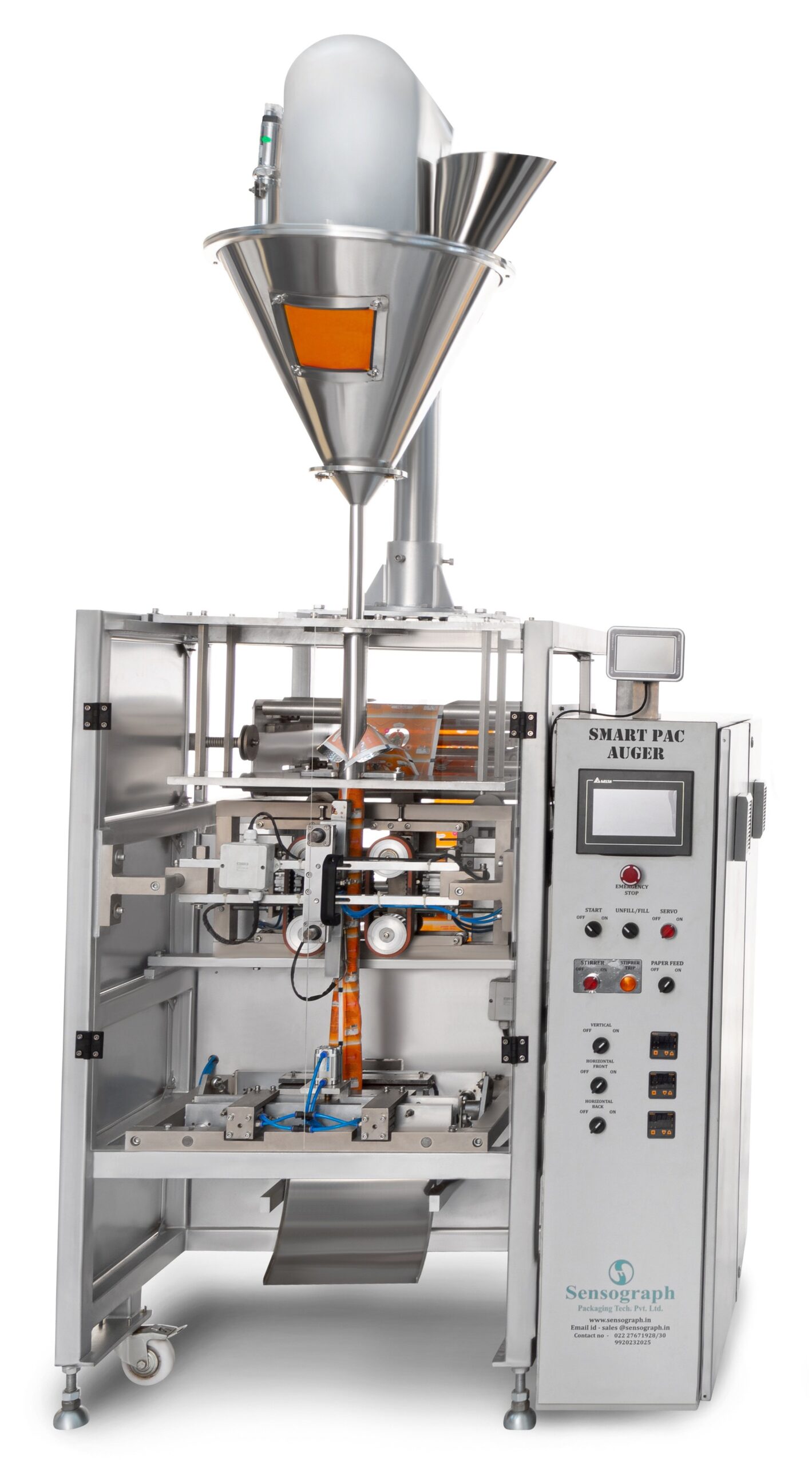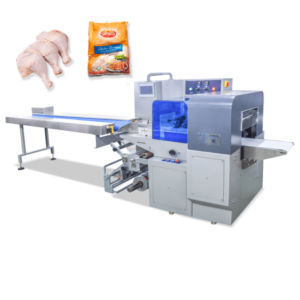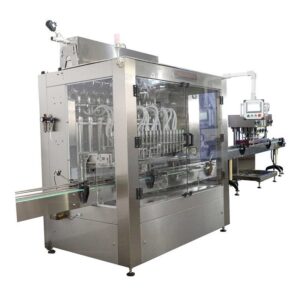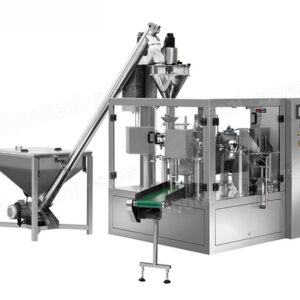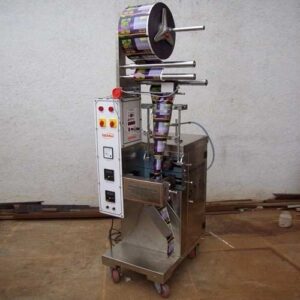Description
| Feature | Specification |
|---|---|
| Model | XYZ-2000 |
| Packaging Type | Powder |
| Packaging Speed | Up to 60 bags per minute |
| Bag Size Range | Width: 50mm – 200mm, Length: 50mm – 300mm |
| Bag Material | Heat-sealable laminated film |
| Filling Method | Auger filler |
| Power Supply | 220V/50Hz, 1 phase or customized |
| Power Consumption | 3.5kW |
| Air Pressure | 0.6MPa |
| Air Consumption | 0.4m³/min |
| Control System | PLC control system with touchscreen HMI |
| Accuracy | ±0.2-1.5% (depending on the product) |
| Packaging Material Consumption | 0.2m³/min |
| Machine Weight | Approx. 600kg |
| Machine Dimensions | 1400mm (L) x 1000mm (W) x 1800mm (H) |
| Optional Equipment | Date coder, nitrogen flushing system, metal detector, etc. |
The powder packaging machine is a vital component within industrial settings, facilitating the efficient and precise packaging of powdered substances. Designed with advanced technology, these machines streamline the packaging process, ensuring consistency, accuracy, and hygiene. They are commonly employed across various sectors including food, pharmaceuticals, chemicals, and cosmetics.
Equipped with features such as adjustable filling volumes, sealing mechanisms, and packaging materials compatibility, these machines cater to diverse packaging requirements. The process typically involves metering the precise quantity of powder, forming and filling individual packages, and sealing them securely to maintain product freshness and integrity.
Powder packaging machines offer numerous benefits to manufacturers, including increased production rates, reduced labor costs, minimized material wastage, and enhanced product presentation. Moreover, their automated operation reduces human error, ensuring high-quality packaging standards and compliance with regulatory requirements.
As industries continue to prioritize efficiency, consistency, and product safety, the demand for advanced powder packaging solutions is expected to rise. With ongoing technological advancements, these machines are poised to become even more sophisticated, offering greater flexibility, reliability, and integration capabilities within modern production environments.
Understanding Powder Packaging Machines
Powder packaging machines encompass a wide range of equipment designed to facilitate the efficient and hygienic packaging of powdered substances. From small-scale operations to large-scale industrial facilities, these machines play a pivotal role in streamlining the packaging process.
Exploring Powder Filling Equipment
Dry Powder Filling Machines
Dry powder filling machines are specifically engineered to handle the unique challenges posed by powdered substances. These machines utilize advanced technology to precisely meter and dispense the desired quantity of powder into packaging containers. Whether it’s spices, pharmaceuticals, or chemicals, dry powder filling machines ensure accurate filling without compromising product quality.
Small Powder Filling Machines
For businesses with limited space or lower production volumes, small powder-filling machines offer a compact and cost-effective solution. These machines are designed to occupy minimal floor space while still delivering efficient and accurate powder-filling capabilities. Ideal for startups and small-scale manufacturers, small powder-filling machines provide the versatility and reliability needed to meet production demands.
Semi-Automatic Powder Filling Machines
Semi-automatic powder-filling machines strike a balance between manual labor and full automation. Operators are involved in certain aspects of the packaging process, such as container placement and product inspection, while the machine handles the actual filling operation. This semi-automated approach enhances productivity and consistency while allowing for greater flexibility in production setups.
The Advantages of Automated Solutions
Automatic Powder Filling Machines
In today’s fast-paced manufacturing environment, automation is key to maximizing efficiency and productivity. Automatic powder-filling machines exemplify this principle by offering fully automated solutions for powder packaging. These machines are capable of handling high-volume production with minimal human intervention, reducing labor costs and minimizing the risk of errors.
Choosing the Right Equipment
When selecting powder packaging equipment, several factors must be taken into account. Production volume, type of powder, packaging material, and budget constraints all influence the choice of machinery. Additionally, considerations such as ease of operation, maintenance requirements, and compatibility with existing production lines play a crucial role in the decision-making process.
Types of powder packaging machine machine
Vertical Form Fill Seal (VFFS) Machines
Vertical form-fill-seal machines are versatile and widely used in the packaging industry. They can handle a variety of packaging materials such as polyethylene, laminates, and more. VFFS machines form bags from a flat roll of film, fill them with the powdered substance, and then seal them vertically. They are known for their high speed and efficiency, making them ideal for large-scale production.
Auger Filling Machines
Auger filling machines are specifically designed for filling powdered substances with precision. They utilize a rotating auger screw to meter and dispense the powder into containers, ensuring accurate filling volumes. Auger fillers are suitable for both free-flowing and non-free-flowing powders and are often used in pharmaceuticals, spices, and chemicals.
Pre-made Pouch Fill Seal Machines
Pre-made pouch fill seal machines are ideal for packaging powdered substances into pre-formed pouches or bags. These machines can handle various pouch styles, including stand-up pouches, flat pouches, and more. They fill the pouches with the desired amount of powder and then seal them to ensure product freshness and integrity. Pre-made pouch-fill seal machines offer flexibility and customization options for packaging designs.
Weight-based Filling Machines
Weight-based filling machines utilize scales to measure and dispense the precise weight of powdered substances into containers. These machines are highly accurate and are commonly used in industries where precise dosing is critical, such as pharmaceuticals and nutritional supplements. Weight-based filling machines ensure consistency in product weight and minimize product giveaways.
Semi-automatic and Automatic Machines
Powder packaging machines can also be categorized based on automation levels. Semi-automatic machines require some manual intervention, such as placing containers or initiating the packaging process, while automatic machines operate with minimal human involvement. Automatic machines are preferred for high-volume production, as they offer increased efficiency and productivity.
Applications of powder packaging machine machine
Food Industry
In the food industry, powder packaging machines are extensively used for packaging a wide range of powdered food products. This includes spices, flour, baking mixes, powdered drink mixes, and more. These machines ensure accurate filling and sealing of packaging containers, preserving the freshness and flavor of the food products. Whether it’s individual sachets or bulk packaging, powder packaging machines cater to the diverse needs of the food industry, meeting stringent hygiene and quality standards.
Pharmaceutical Industry
The pharmaceutical industry relies heavily on powder packaging machines for the precise and hygienic packaging of pharmaceutical powders. From medications to nutritional supplements and powdered vitamins, these machines ensure accurate dosing and sealing to maintain product efficacy and safety. Pharmaceutical-grade powder packaging machines adhere to strict regulatory requirements, including GMP (Good Manufacturing Practices), ensuring compliance with industry standards and regulations.
Chemical Industry
Powder packaging machines play a crucial role in the chemical industry for packaging various powdered chemicals and compounds. These can include fertilizers, pesticides, detergents, and industrial chemicals. Powder packaging machines ensure the safe and efficient handling of potentially hazardous substances, preventing contamination and ensuring product integrity. Additionally, these machines offer customization options for packaging sizes and materials to meet the specific needs of chemical manufacturers.
Cosmetics Industry
In the cosmetics industry, powder packaging machines are utilized for packaging a wide range of powdered beauty products such as face powders, blushes, eyeshadows, and talcum powders. These machines enable precise filling and sealing of cosmetic containers, ensuring product consistency and aesthetics. Whether it’s loose powders or pressed powders, powder packaging machines cater to the diverse packaging requirements of cosmetic manufacturers, enhancing product presentation and shelf appeal.
Agricultural Industry
In the agricultural sector, powder packaging machines are essential for packaging powdered agricultural products such as seeds, fertilizers, pesticides, and animal feed supplements. These machines ensure accurate dosing and sealing of packaging containers, preserving the quality and efficacy of agricultural products. Powder packaging machines in the agricultural industry are designed to withstand harsh environmental conditions and rugged handling, facilitating efficient packaging operations in farm settings and distribution centers.
Functionalities of powder packaging machine machine
Metering and Dispensing
One of the primary functionalities of powder packaging machines is metering and dispensing the desired quantity of powdered substance into packaging containers. This process is crucial for ensuring consistency in product weight or volume. Powder packaging machines utilize different mechanisms such as augers, weigh scales, or volumetric fillers to accurately measure and dispense the powder according to predefined parameters.
Filling Mechanisms
Powder packaging machines employ various filling mechanisms to transfer the powdered substance from the storage hopper into the packaging containers. Common filling mechanisms include auger filling, gravity filling, vacuum filling, and piston filling. These mechanisms ensure uniform filling and prevent powder spillage or wastage during the packaging process.
Packaging Material Handling
Powder packaging machines are equipped to handle a variety of packaging materials, including paper bags, plastic pouches, sachets, jars, and bottles. These machines can accommodate different sizes, shapes, and types of packaging containers to meet specific product requirements. Advanced powder packaging machines feature adjustable mechanisms for handling different packaging materials and sizes seamlessly.
Sealing Systems
Sealing is a critical aspect of the packaging process to ensure product freshness, integrity, and tamper resistance. Powder packaging machines are equipped with sealing systems that employ various techniques such as heat sealing, ultrasonic sealing, or vacuum sealing, depending on the packaging material and product characteristics. These sealing systems ensure secure closure of packaging containers to prevent leakage or contamination.
Integrated Controls and Automation
Modern powder packaging machines feature advanced control systems and automation technology to streamline production processes and improve efficiency. These machines are equipped with user-friendly interfaces, touchscreen panels, and programmable logic controllers (PLCs) that allow operators to set parameters, monitor production status, and troubleshoot issues easily. Automation features such as auto-start, auto-stop, and recipe storage enhance operational efficiency and reduce human intervention.
Customization Options
Powder packaging machines offer customization options to accommodate diverse packaging requirements and product specifications. Manufacturers can tailor the machine settings for different fill volumes, packaging formats, and sealing configurations to meet specific customer demands. Additionally, powder packaging machines can be equipped with additional features such as printing systems for batch coding, label application, and product inspection systems for quality control.
Hygiene and Cleanability
Hygiene is paramount in industries such as food, pharmaceuticals, and cosmetics. Powder packaging machines are designed with hygiene in mind, featuring sanitary construction materials, smooth surfaces, and easy-to-clean components. These machines incorporate quick-change parts and tool-less disassembly for thorough cleaning and sanitation between production runs, ensuring compliance with industry regulations and standards.
Safety Features
Safety is a top priority in industrial environments, and powder packaging machines are equipped with various safety features to protect operators and prevent accidents. These features include emergency stop buttons, safety interlocks, guarding, and safety sensors to detect anomalies or obstructions during operation. Additionally, powder packaging machines undergo rigorous testing and certification to ensure compliance with safety standards and regulations.
Frequently Asked Questions
- What is a powder packaging machine?
A powder packaging machine is a specialized equipment used in various industries to efficiently fill, seal, and package powdered substances into containers such as bags, pouches, bottles, or jars.
- What types of powders can be packaged using these machines?
Powder packaging machines can handle a wide range of powders including food products like spices, flour, and coffee, pharmaceuticals, chemicals, cosmetics, and agricultural products like fertilizers and pesticides.
- How do powder packaging machines work?
These machines typically involve processes such as metering the powder, filling containers, sealing them, and sometimes labeling or coding them. Depending on the type of machine, the powder may be measured using augers, scales, or volumetric fillers.
- What are the different types of powder packaging machines available?
Common types include Vertical Form Fill Seal (VFFS) machines, auger filling machines, pre-made pouch fill seal machines, weight-based filling machines, and semi-automatic or automatic machines.
- How accurate are powder packaging machines in filling containers?
Powder packaging machines are designed to be highly accurate, with precision measurements and control mechanisms ensuring consistent filling volumes, minimizing product giveaways, and reducing waste.
- Can powder packaging machines handle different packaging materials and sizes?
Yes, most powder packaging machines are versatile and can accommodate various packaging materials such as paper, plastic, laminates, and different sizes and shapes of containers.
- What are the benefits of using powder packaging machines?
Benefits include increased production efficiency, improved product quality and consistency, reduced labor costs, minimized material wastage, enhanced hygiene standards, and compliance with regulatory requirements.
- How easy is it to operate and maintain a powder packaging machine?
Modern powder packaging machines are designed for ease of operation and maintenance, with user-friendly interfaces, intuitive controls, and easy-to-clean components. Regular maintenance schedules help ensure optimal performance and longevity.
- Are powder packaging machines customizable to suit specific production needs?
Yes, many powder packaging machines offer customization options such as adjustable filling volumes, sealing configurations, and compatibility with different packaging materials, allowing manufacturers to tailor them to their specific requirements.
- What safety features do powder packaging machines have?
Powder packaging machines are equipped with various safety features including emergency stop buttons, safety interlocks, guards, and sensors to detect anomalies during operation, ensuring the safety of operators and preventing accidents.

